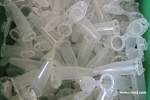We tend to think of recent biomedical artefacts as more or less spectacular high-tech things, like gene sequencers, PET scanners, PCR machines or knock-out mice. But many vital artefacts in the biomedical laboratory or medical clinic are mundane things — like plastic gloves, ink markers and centrifuge tubes. They may not be so fancy, but they are essential for the way the lab works.
Some of these mundane objects are more sophisticated than they immediately appear, however. Take, for example, the Eppendorf tube:

(thanks to Goodies: Things we would like to share)
This disposable little plastic centrifuge tube — named after the (then West) German company Eppendorf AG that produced them — was designed in 1962 for microliter volumes; it rapidly became popular among lab people around the world, and today it belongs to the non-assuming (but essential) infrastructural staple ware of recent biomedicine; in fact about 3,000 million tubes are sold each year.
Much of the contemporary history of biomedicine, at least in the last 40 years, revolves around these tiny tubes and other mundane biomedical artefacts. Anybody interested in writing the “biography” of any of these artefacts? What about Eppy: The Tube That Changed Biopolitics? — a PhD thesis-turned-bestseller that will beat all the “biographies” in recent years about more well-known objects like barbed wire, salt, or cod back to oblivion.
(Inspired by Reza Hashemi’s note on the Eppendorf tube in the last issue of The Scientist. )
The history of everyday lab artefacts
We tend to think of recent biomedical artefacts as more or less spectacular high-tech things, like gene sequencers, PET scanners, PCR machines or knock-out mice. But many vital artefacts in the biomedical laboratory or medical clinic are mundane things — like plastic gloves, ink markers and centrifuge tubes. They may not be so fancy, but […]


